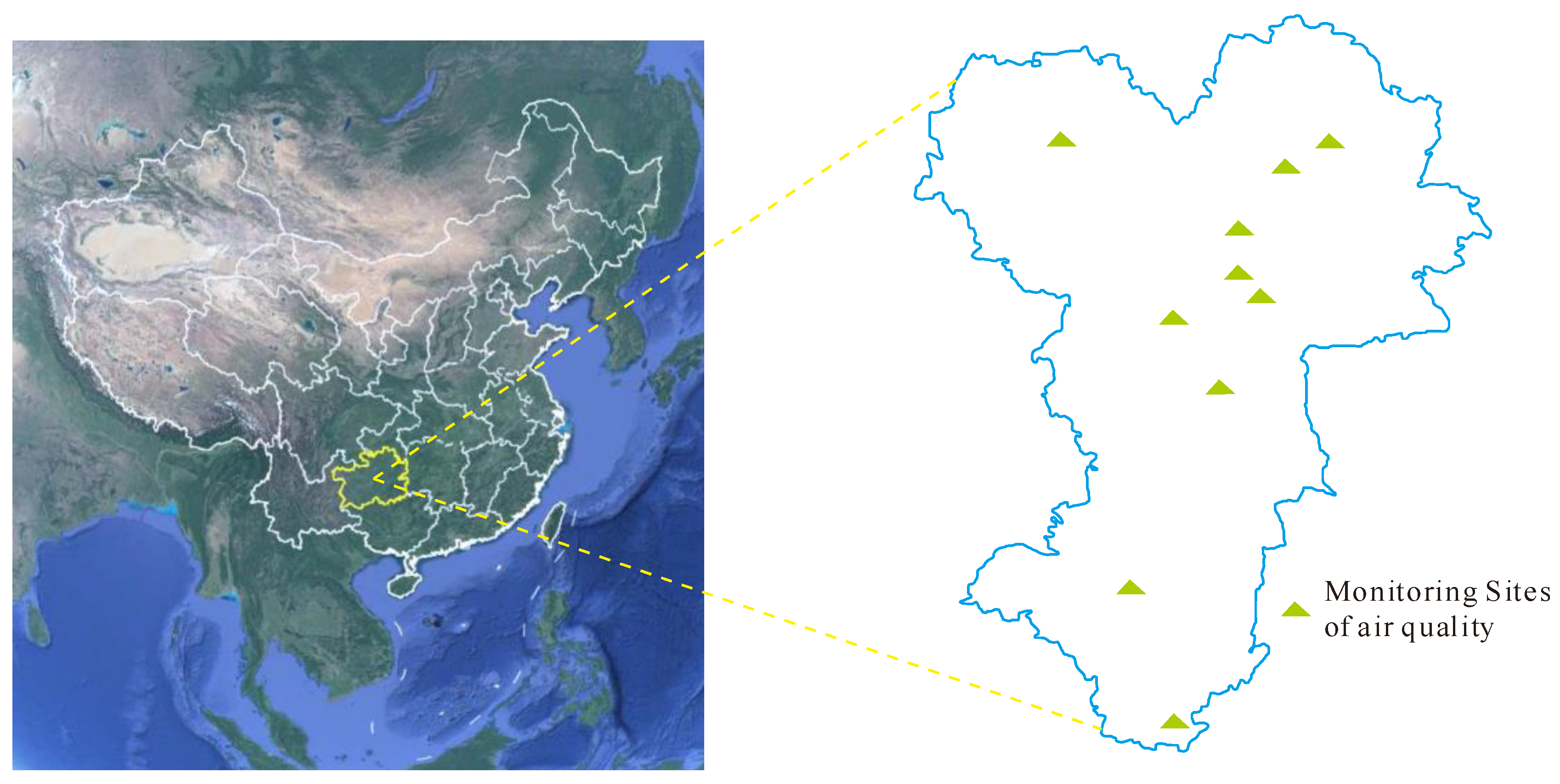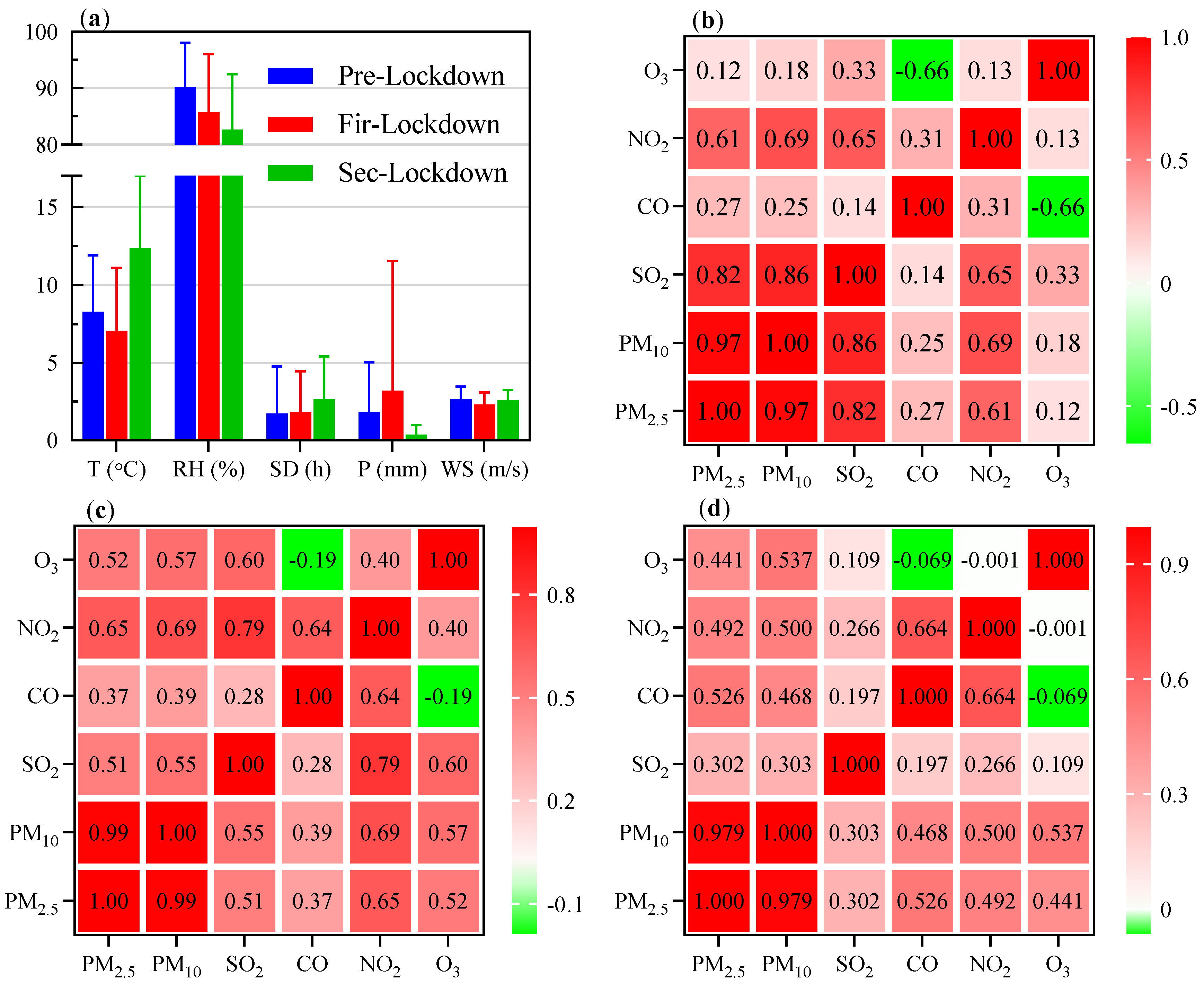The Multi-Time Scale Changes in Air Pollutant Concentrations and Its Mechanism before and during the COVID-19 Periods: A Case Study from Guiyang, Guizhou Province
Abstract
:1. Introduction
2. Materials and Methods
2.1. Regional Overview and Data Sources
2.2. The Definition of Lockdown Stage and Research Methods
3. Results
3.1. Change Characteristics of the Mean Concentrations of Air Pollutants during the Three Stages
3.2. Change Characteristics of Daily Mean Concentration of Air Pollutants
3.3. Change Characteristics of Hourly Mean Concentrations of Air Pollutants
4. Discussion
4.1. Effect of Meteorological Conditions on Air Pollutant Concentrations
4.2. Generation of Secondary Aerosols and Its Impact on Air Quality
4.3. Policy Implications for Quality Prevention and Control
4.4. Existing Problems and Deficiencies
5. Conclusions
Author Contributions
Funding
Institutional Review Board Statement
Informed Consent Statement
Data Availability Statement
Conflicts of Interest
References
- Rajbhandari, B.; Phuyal, N.; Shrestha, B.; Thapa, M. Air Medical Evacuation of Nepalese Citizen during Epidemic of COVID-19 from Wuhan to Nepal. J. Nepal Med. Assoc. 2020, 58, 125–133. [Google Scholar] [CrossRef]
- Cohen, J.; Kupferschmidt, K. Strategies shift as coronavirus pandemic looms. Science 2020, 367, 962–963. [Google Scholar] [CrossRef] [PubMed] [Green Version]
- Pepe, E.; Bajardi, P.; Gauvin, L.; Privitera, F.; Lake, B.; Cattuto, C.; Tizzoni, M. COVID-19 outbreak response: A first assessment of mobility changes in Italy following national lockdown. Sci. Data 2020, 7, 230. [Google Scholar] [CrossRef] [PubMed]
- Li, L.; Li, Q.; Huang, L.; Wang, Q.; Zhu, A.; Xu, J.; Liu, Z.; Li, H.; Shi, L.; Li, R.; et al. Air quality changes during the COVID-19 lockdown over the Yangtze River Delta Region: An insight into the impact of human activity pattern changes on air pollution variation. Sci. Total Environ. 2020, 732, 139–282. [Google Scholar] [CrossRef] [PubMed]
- Xu, C.; Wu, S.; Liu, Y.; Zhong, X. Response of Air Quality to COVID-19 Lockdown in Xiamen Bay. Environ. Sci. 2021, 42, 4650–4659. (In Chinese) [Google Scholar]
- Le, T.; Wang, Y.; Liu, L.; Yang, J.; Yung, Y.L.; Li, G.; Seinfeld, J.H. Unexpected air pollution with marked emission reductions during the COVID-19 outbreak in China. Science 2020, 369, 702–706. [Google Scholar] [CrossRef]
- Bray, C.D.; Nahas, A.; Battye, W.H.; Aneja, V.P. Impact of lockdown during the COVID-19 outbreak on multi-scale air quality. Atmos. Environ. 2021, 254, 118386. [Google Scholar] [CrossRef]
- Chen, J.; Feng, X.; Li, Y.; Wang, S. Analysis of Air Quality and Influencing Factors in Sichuan Basin during the COVID-19. Environ. Sci. 2021, 1–12. (In Chinese). Available online: https://kns.cnki.net/kcms/detail/detail.aspx?dbcode=CAPJ&dbname=CAPJLAST&filename=HJKZ2021061000C&uniplatform=NZKPT&v=xQUCJGvGRRGjisa01h7n4jmUlfGKfAa6nfJP2PVQBztmGpX7l3BUGiZmWDewuSKd (accessed on 4 November 2021).
- Lee, J.D.; Drysdale, W.S.; Finch, D.P.; Wilde, S.E.; Palmer, P.I. UK surface NO2 levels dropped by 42% during the COVID-19 lockdown: Impact on surface O3. Atmos. Chem. Phys. 2020, 20, 15743–15759. [Google Scholar] [CrossRef]
- Su, Z.; Duan, Z.; Deng, B.; Liu, Y.; Chen, X. Impact of the COVID-19 Lockdown on Air Quality Trends in Guiyang, Southwestern China. Atmosphere 2021, 12, 422. [Google Scholar] [CrossRef]
- Shi, X.; Brasseur, G.P. The Response in Air Quality to the Reduction of Chinese Economic Activities during the COVID-19 Outbreak. Geophys. Res. Lett. 2020, 47, e2020GL088070. [Google Scholar] [CrossRef] [PubMed]
- Levy, M.; Zhang, R.; Zheng, J.; Zhang, A.; Xu, W.; Gomez Hernandez, M.; Wang, Y.; Olaguer, E.P. Measurements of nitrous acid (HONO) using ion drift-chemical ionization mass spectrometry during the 2009 SHARP field campaign. Atmos. Environ. 2014, 94, 231–240. [Google Scholar] [CrossRef]
- Shi, Z.; Song, C.; Liu, B.; Lu, G.; Xu, J.; Van Vu, T.; Elliott, R.J.R.; Li, W.; Bloss, W.J.; Harrison, R.M. Abrupt but smaller than expected changes in surface air quality attributable to COVID-19 lockdowns. Sci. Adv. 2021, 7, eabd6696. [Google Scholar] [CrossRef] [PubMed]
- Hammer, M.S.; van Donkelaar, A.; Martin, R.V.; McDuffie, E.E.; Lyapustin, A.; Sayer, A.M.; Hsu, N.C.; Levy, R.C.; Garay, M.J.; Kalashnikova, O.V.; et al. Effects of COVID-19 lockdowns on fine particulate matter concentrations. Sci. Adv. 2021, 7, eabg7670. [Google Scholar] [CrossRef] [PubMed]
- Adam, M.G.; Tran, P.T.M.; Balasubramanian, R. Air quality changes in cities during the COVID-19 lockdown: A critical review. Atmos. Res. 2021, 264, 105823. [Google Scholar] [CrossRef]
- Wang, P.; Chen, K.; Zhu, S.; Wang, P.; Zhang, H. Severe air pollution events not avoided by reduced anthropogenic activities during COVID-19 outbreak. Resour. Conserv. Recycl. 2020, 158, 104814. [Google Scholar] [CrossRef]
- Shu, Z.; Zhao, T.; Zheng, X.; Qiu, Y.; Shi, R.; Jia, M. Air quality variations and meteorological drivers of Guiyang city in clean atmospheric environment. China Environ. Sci. 2017, 37, 4460–4468. (In Chinese) [Google Scholar]
- Shang, Y.; Shu, Z.; Zheng, X.; Zhao, T.; Liao, Y.; Jia, M. Interaction Mechanism between PM2.5 and O3 in Winter and Summer in Yunnan-Guizhou Plateau: A Case Study of Guiyang. Ecol. Environ. Sci. 2018, 27, 2284–2289. (In Chinese) [Google Scholar]
- Su, Z.; Han, H.; Chen, B. Spatial and temporal variation and combined pollution characteristics of atmospheric pollutants in urban Guiyang. Carsologica Sin. 2020, 39, 442–452. (In Chinese) [Google Scholar]
- Venter, Z.S.; Aunan, K.; Chowdhury, S.; Lelieveld, J. COVID-19 lockdowns cause global air pollution declines. Proc. Natl. Acad. Sci. USA 2020, 117, 18984–18990. [Google Scholar] [CrossRef]
- Li, R.; Mei, X.; Wei, L.; Han, X.; Zhang, M.; Jing, Y. Study on the contribution of transport to PM2.5 in typical regions of China using the regional air quality model RAMS-CMAQ. Atmos. Environ. 2019, 214, 116856. [Google Scholar] [CrossRef]
- Wang, Z.; Li, Y.; Chen, T.; Zhang, D.; Sun, F.; Wei, Q.; Dong, X.; Sun, R.; Huan, N.; Pan, L. Ground-level ozone in urban Beijing over a 1-year period: Temporal variations and relationship to atmospheric oxidation. Atmos. Res. 2015, 164–165, 110–117. [Google Scholar] [CrossRef]
- Cheung, V.T.F.; Wang, T. Observational study of ozone pollution at a rural site in the Yangtze Delta of China. Atmos. Environ. 2001, 35, 4947–4958. [Google Scholar] [CrossRef]
- Shah, V.; Jaegle, L.; Thornton, J.A.; Lopez-Hilfiker, F.D.; Lee, B.H.; Schroder, J.C.; Campuzano-Jost, P.; Jimenez, J.L.; Guo, H.; Sullivan, A.P.; et al. Chemical feedbacks weaken the wintertime response of particulate sulfate and nitrate to emissions reductions over the eastern United States. Proc. Natl. Acad. Sci. USA 2018, 115, 8110–8115. [Google Scholar] [CrossRef] [Green Version]
- Pozzer, A.; Tsimpidi, A.P.; Karydis, V.A.; de Meij, A.; Lelieveld, J. Impact of agricultural emission reductions on fine-particulate matter and public health. Atmos. Chem. Phys. 2017, 17, 12813–12826. [Google Scholar] [CrossRef] [Green Version]
- Chen, H.; Huo, J.; Fu, Q.; Duan, Y.; Xiao, H.; Chen, J. Impact of quarantine measures on chemical compositions of PM2.5 during the COVID-19 epidemic in Shanghai, China. Sci. Total Environ. 2020, 743, 140758. [Google Scholar] [CrossRef] [PubMed]
- Wang, Y.; Li, Z.; Wang, Q.; Jin, X.; Yan, P.; Cribb, M.; Li, Y.; Yuan, C.; Wu, H.; Wu, T.; et al. Enhancement of secondary aerosol formation by reduced anthropogenic emissions during Spring Festival 2019 and enlightenment for regional PM2.5 control in Beijing. Atmos. Chem. Phys. 2021, 21, 915–926. [Google Scholar] [CrossRef]
- Heintzenberg, J. Fine particles in the global troposphere: A review. Tellus B 1989, 41, 149–160. [Google Scholar] [CrossRef]
- Wang, G.; Zhang, R.; Gomez, M.E.; Yang, L.; Zamora, M.L.; Hu, M.; Lin, Y.; Peng, J.; Guo, S.; Meng, J.; et al. Persistent sulfate formation from London Fog to Chinese haze. Proc. Natl. Acad. Sci. USA 2016, 113, 13630–13635. [Google Scholar] [CrossRef] [PubMed] [Green Version]
- Gen, M.; Zhang, R.; Huang, D.D.; Li, Y.; Chan, C.K. Heterogeneous SO2 Oxidation in Sulfate Formation by Photolysis of Particulate Nitrate. Environ. Sci. Technol. Lett. 2019, 6, 86–91. [Google Scholar] [CrossRef]
- Sun, W.; Wang, D.; Yao, L.; Fu, H.; Wang, H.; Li, Q.; Wang, L.; Yang, L.; Xian, A.; Wang, G.; et al. Chemistry-triggered events of PM2.5 explosive growth during late autumn and winter in Shanghai, China. Environ. Pollut. 2019, 254, 112864. [Google Scholar] [CrossRef] [PubMed]
- Wang, G.; Zhang, F.; Peng, J.; Duan, L.; Ji, Y.; Marrero-Ortiz, W.; Wang, J.; Li, J.; Wu, C.; Cao, C.; et al. Particle acidity and sulfate production during severe haze events in China cannot be reliably inferred by assuming a mixture of inorganic salts. Atmos. Chem. Phys. 2018, 18, 10123–10132. [Google Scholar] [CrossRef] [Green Version]
- Sun, Y.; Lei, L.; Zhou, W.; Chen, C.; He, Y.; Sun, J.; Li, Z.; Xu, W.; Wang, Q.; Ji, D.; et al. A chemical cocktail during the COVID-19 outbreak in Beijing, China: Insights from six-year aerosol particle composition measurements during the Chinese New Year holiday. Sci. Total Environ. 2020, 742, 140739. [Google Scholar] [CrossRef] [PubMed]





| Pollutant Item | T | RH | WS | SD | P | AP |
|---|---|---|---|---|---|---|
| PM2.5 | 0.29 | −0.36 | −0.35 | 0.17 | −0.33 | −0.05 |
| PM10 | 0.41 | −0.42 | −0.30 | 0.25 | −0.36 | −0.12 |
| SO2 | −0.02 | −0.58 | −0.51 | 0.38 | −0.24 | 0.09 |
| CO | −0.23 | 0.41 | −0.30 | −0.23 | −0.11 | −0.12 |
| NO2 | 0.19 | −0.01 | −0.22 | 0.17 | −0.15 | −0.34 |
| O3 | 0.51 | −0.77 | 0.04 | 0.58 | −0.15 | −0.16 |
Publisher’s Note: MDPI stays neutral with regard to jurisdictional claims in published maps and institutional affiliations. |
© 2021 by the authors. Licensee MDPI, Basel, Switzerland. This article is an open access article distributed under the terms and conditions of the Creative Commons Attribution (CC BY) license (https://creativecommons.org/licenses/by/4.0/).
Share and Cite
Su, Z.; Li, X.; Liu, Y.; Deng, B. The Multi-Time Scale Changes in Air Pollutant Concentrations and Its Mechanism before and during the COVID-19 Periods: A Case Study from Guiyang, Guizhou Province. Atmosphere 2021, 12, 1490. https://doi.org/10.3390/atmos12111490
Su Z, Li X, Liu Y, Deng B. The Multi-Time Scale Changes in Air Pollutant Concentrations and Its Mechanism before and during the COVID-19 Periods: A Case Study from Guiyang, Guizhou Province. Atmosphere. 2021; 12(11):1490. https://doi.org/10.3390/atmos12111490
Chicago/Turabian StyleSu, Zhihua, Xin Li, Yunlong Liu, and Bing Deng. 2021. "The Multi-Time Scale Changes in Air Pollutant Concentrations and Its Mechanism before and during the COVID-19 Periods: A Case Study from Guiyang, Guizhou Province" Atmosphere 12, no. 11: 1490. https://doi.org/10.3390/atmos12111490
APA StyleSu, Z., Li, X., Liu, Y., & Deng, B. (2021). The Multi-Time Scale Changes in Air Pollutant Concentrations and Its Mechanism before and during the COVID-19 Periods: A Case Study from Guiyang, Guizhou Province. Atmosphere, 12(11), 1490. https://doi.org/10.3390/atmos12111490






